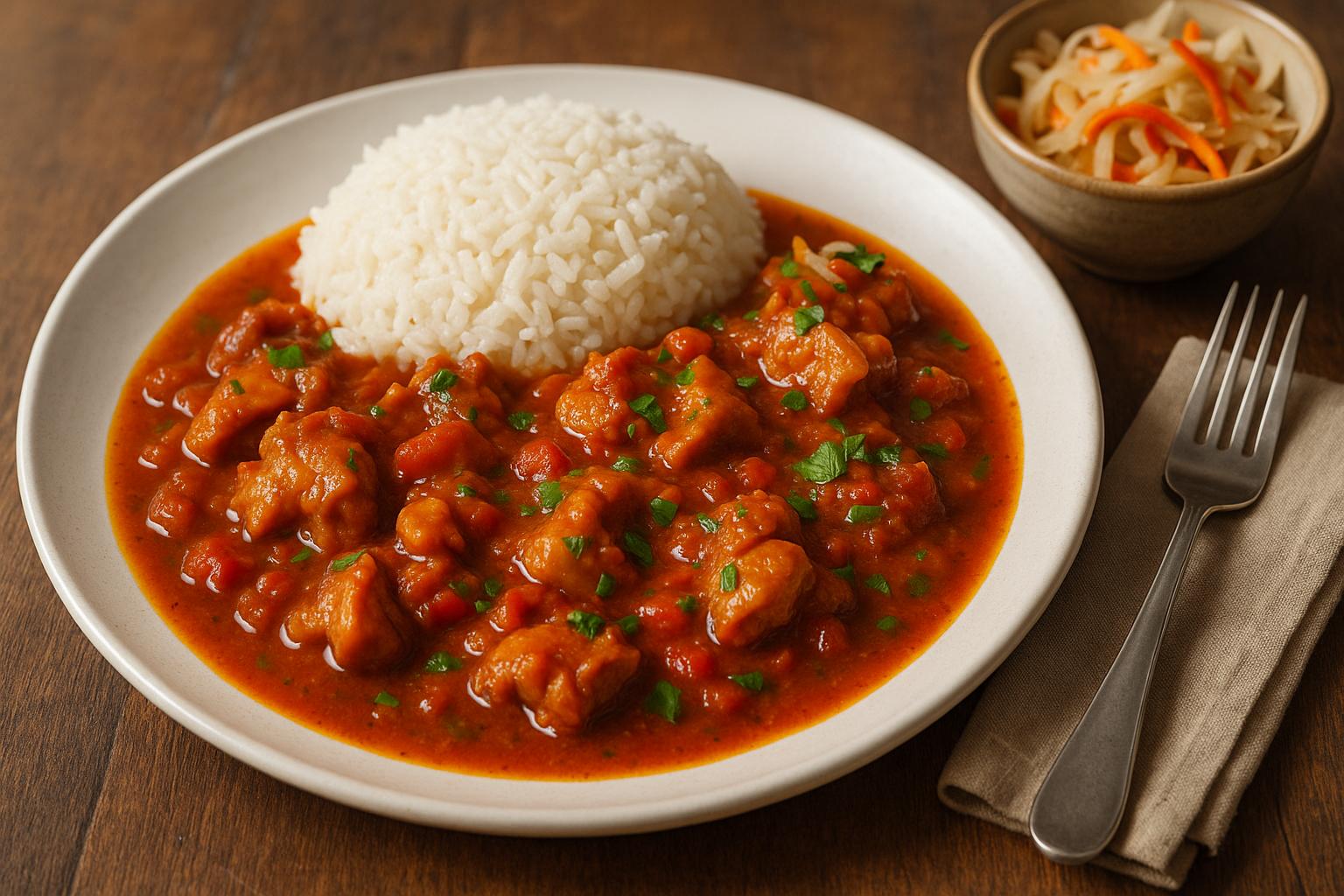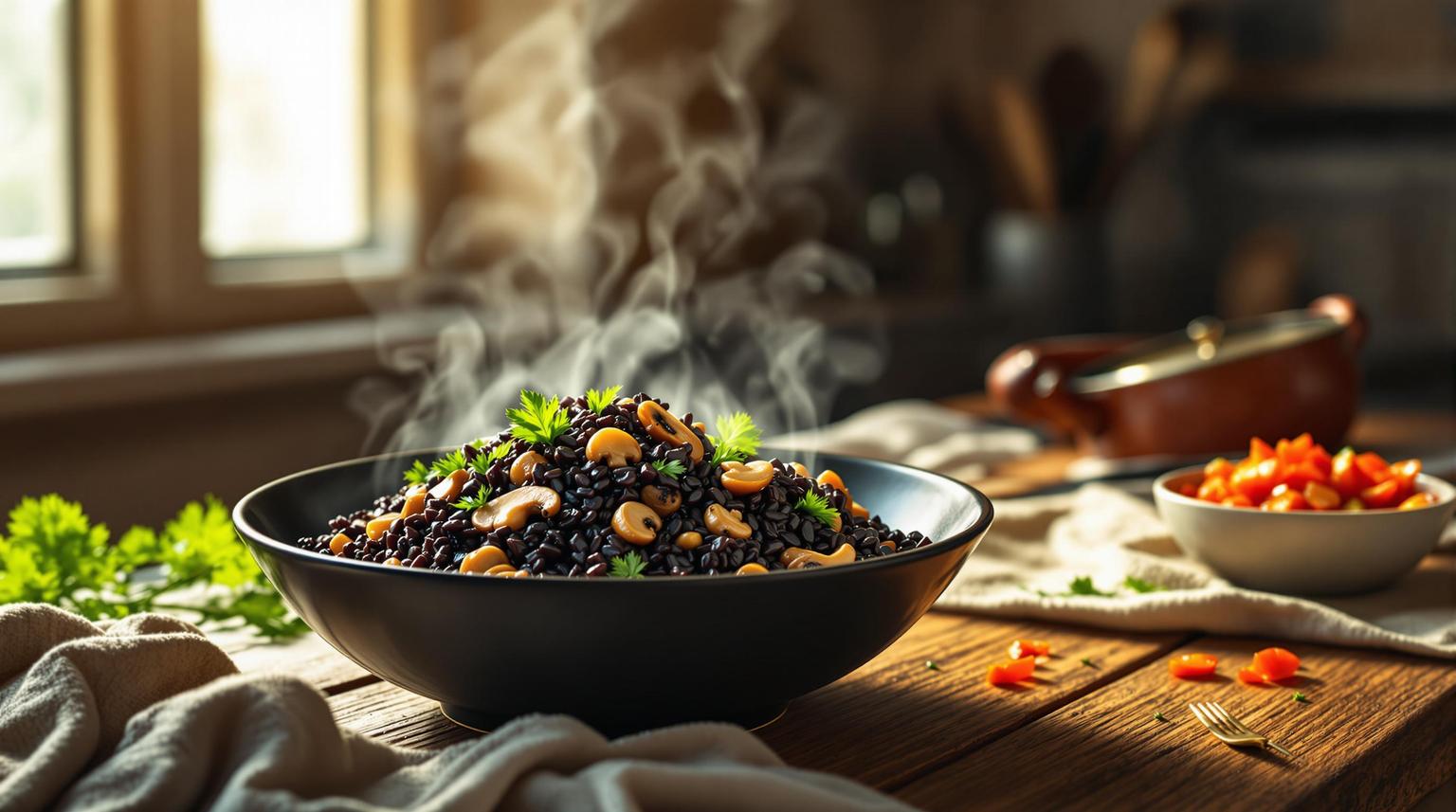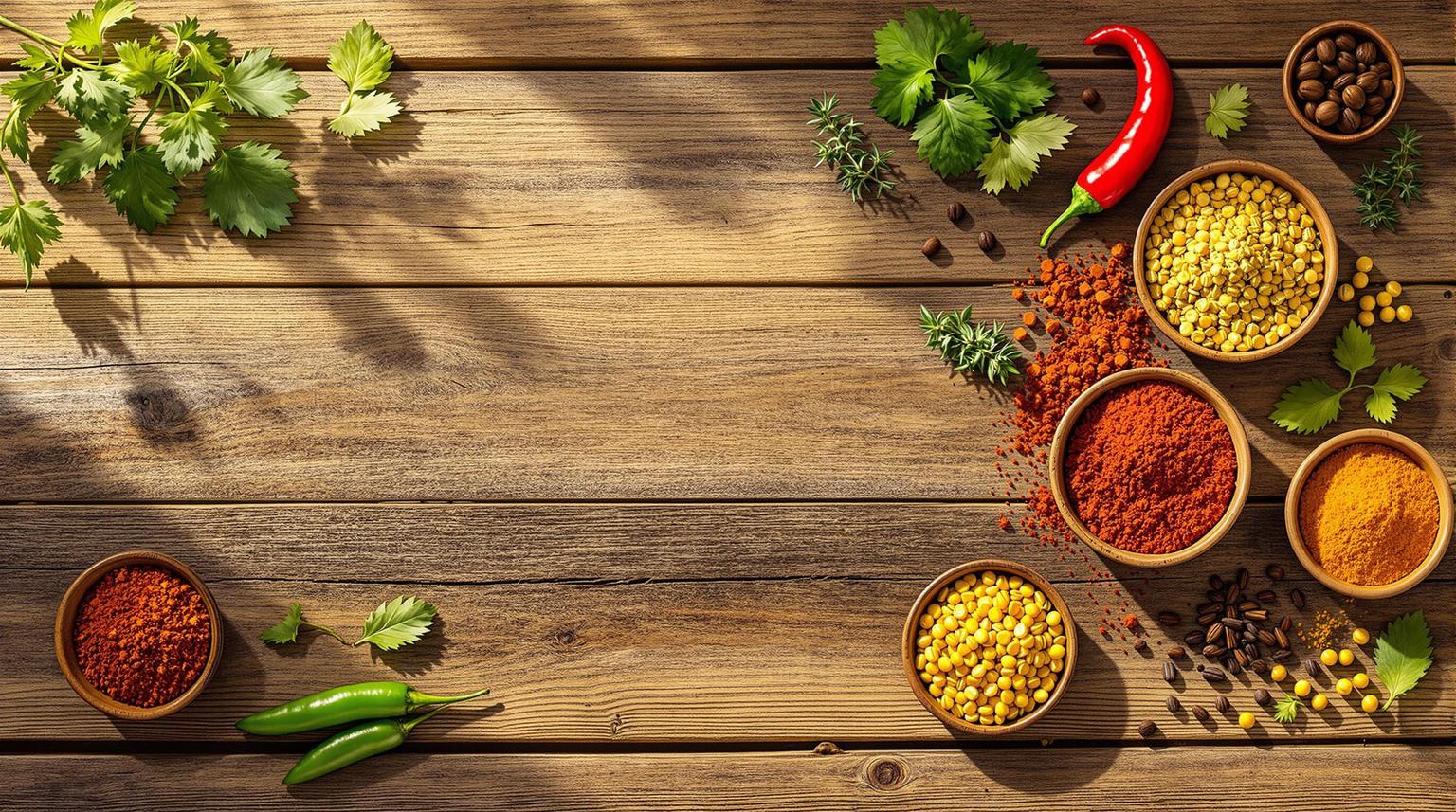Haitian cuisine is a flavorful way to connect with guests and share meaningful traditions. The dishes, from griyo (fried pork) to soup joumou (pumpkin soup), reflect Haiti's history and hospitality. Each meal is prepared with care, combining bold flavors and rich textures that leave a lasting impression. Here’s a quick rundown of must-try dishes when hosting:
- Griyo: Crispy, tender fried pork paired with spicy pikliz and fried plantains.
- Soup Joumou: A hearty pumpkin soup symbolizing freedom, served with bread.
- Diri Djon Djon: Black mushroom rice, perfect for special occasions.
- Pwason ak Bannann Peze: Fried fish with twice-fried plantains.
- Lambi: Slow-cooked conch stew in a rich, aromatic sauce.
Side dishes like Mayi Moulen ak Sòs Pwa (cornmeal with bean sauce) and condiments like Pikliz (spicy pickled vegetables) add balance and variety. Hosting Haitian-style means more than just serving food - it's about creating a warm, welcoming atmosphere.
Every Haitian Dish You Need to Try | KQED No Crumbs

Main Haitian Dishes for Hosting Guests
When welcoming guests in Haitian culture, the menu often becomes a showcase of Haiti's rich culinary traditions. These dishes carry not just bold flavors but also deep cultural stories, leaving a lasting impression on anyone lucky enough to enjoy them. Below are some standout dishes that define the art of Haitian hospitality.
Griyo (Fried Pork)
Griyo is a quintessential dish in Haitian cuisine, often considered a must-have at any gathering. Made from pork shoulder marinated overnight in epis (a Haitian spice blend), then braised and fried, it delivers a satisfying combination of crispy edges and tender, juicy meat.
"Often considered the national dish of Haiti, Griot is made of pieces of pork shoulder that are marinated, cooked, and then fried until crispy brown. Serve this dish with Pikliz and fried plantains for a true taste of Haiti!" - Alexandria Drzazgowski, The Foreign Fork [2]
This dish is a crowd-pleaser, thanks to its bold flavors and shareable nature. A 2023 recipe for Haitian Griot and Pikliz on Tasty.co received glowing reviews, with 95% of users saying they’d make it again [2]. To get the best results, marinate the pork overnight to deepen the flavors and ensure it's completely dry before frying to avoid oil splatters. Pair it with pikliz (spicy pickled vegetables) and fried plantains for a mouthwatering combination of tangy, spicy, and savory flavors. Next, we delve into a dish with historical roots.
Soup Joumou (Pumpkin Soup)
Soup Joumou isn’t just food - it’s a symbol of freedom and resilience. This golden, hearty soup carries profound historical meaning. Once forbidden to enslaved Africans who prepared it for French colonizers, it became a symbol of liberation when Marie-Claire Heureuse Félicité Bonheur Dessalines served it to freed Haitians on January 1, 1804. In 2021, UNESCO recognized its importance, adding it to the Representative List of the Intangible Cultural Heritage of Humanity [3].
"The soup represents the claiming and reconfiguration of a colonial dish into an anti-colonial symbol of resistance and also Black freedom, specifically Haitian freedom." - Bertin Louis Jr., cultural anthropologist at the University of Kentucky [4]
To prepare this dish, marinated meat is simmered until tender, while winter squash is cooked and pureed into a smooth, flavorful base. Vegetables like leeks, carrots, celery, and malanga, along with vermicelli pasta and spices, are added to create a rich, satisfying soup that’s perfect for sharing. Serve it hot with sliced French bread for dipping, and you’ve got a meal that’s both delicious and deeply meaningful.
Diri Djon Djon (Black Mushroom Rice)
Diri Djon Djon is the crown jewel of Haitian festive cooking, reserved for special occasions and honored guests. Its striking black color and earthy flavor come from djon-djon mushrooms, which are native to northern Haiti. This dish reflects Haiti’s culinary heritage, blending influences from African and Taíno traditions.
For a touch of elegance, garnish the rice with grilled shrimp or lobster tails. It pairs beautifully with grilled meats or vegetables, especially when served with a side of pikliz. This dish not only impresses with its flavor but also connects diners to Haiti’s cultural roots. From the land, we move to the sea with a dish that celebrates Haiti’s coastal bounty.
Pwason ak Bannann Peze (Fried Fish with Fried Plantains)
Pwason ak Bannann Peze highlights Haiti’s coastal flavors, combining fresh fish and twice-fried plantains into a delightful feast. The fish is marinated in lime juice, garlic, and local herbs, then fried until the skin is crisp and the flesh remains tender and flaky. The accompanying bannann peze - plantains fried, smashed, and fried again - adds a sweet and caramelized contrast to the savory fish.
This dish showcases the beauty of simple ingredients elevated through thoughtful preparation. The crispy fish and golden plantains create a harmony of textures and flavors, making it a perfect choice for entertaining. Finally, let’s explore a dish that’s reserved for the most distinguished guests.
Lambi (Conch Stew)
Lambi is the ultimate expression of Haitian hospitality, often served to honored guests. This dish transforms conch, known for its tough texture, into tender, flavorful bites through careful tenderizing and slow cooking. The conch is simmered in a rich, aromatic sauce made with tomatoes, peppers, and traditional Haitian seasonings.
Preparing lambi requires patience and skill, but the result is worth the effort. The stew’s complex flavors develop over hours of cooking, reflecting the care and dedication of the host. Serve lambi with white rice or diri djon djon to soak up the flavorful sauce, creating a meal that’s both comforting and unforgettable.
Each of these dishes offers a taste of Haiti’s culinary artistry and a glimpse into its vibrant culture, ensuring your guests feel welcomed and cherished.
Side Dishes and Accompaniments
Haitian meals shine with side dishes that perfectly balance flavors and add depth to every bite.
Mayi Moulen ak Sòs Pwa (Cornmeal with Bean Sauce)
Mayi Moulen, a velvety cornmeal dish, is Haiti's take on grits[5]. It's often paired with sòs pwa, a savory black bean purée flavored with garlic, thyme, and parsley. Lesley Enston from Bon Appétit describes it best:
"Sos pwa nwa is most often eaten with white rice or mayi moulen, a thick and creamy cornmeal-based dish...similar to polenta but infused with much more flavor thanks to aromatics such as garlic, thyme, and parsley."[8]
To achieve the perfect texture, keep stirring while cooking to avoid lumps and sticking[8]. Serve it hot alongside mori salt fish or the classic black bean purée, and complete the dish with fresh avocado slices for a hearty and satisfying side[6].
Pikliz (Spicy Pickled Vegetables)
Pikliz is a must-have condiment that brings a tangy crunch to Haitian dishes. This spicy, pickled vegetable relish cuts through rich and fatty foods, adding a zesty heat that wakes up your taste buds.
Made with cabbage, carrots, onions, and peppers soaked in vinegar, pikliz develops even more flavor as it sits[9]. In a blog post from July 2025, The Chopping Block highlights its versatility:
"Pikliz (pronounced pick-lees) is a delicious, bright, crunchy, spicy slaw-like pickled condiment of cabbage, carrots, onions, and peppers in vinegar that is often eaten with meats and fried foods...because it helps to balance the flavor, and cuts through the fattiness of those foods." - Kate A from The Chopping Block[9]
When serving dishes like griyo, offer pikliz on the side so guests can either dip their meat in the tangy juice or enjoy it together in one bite[2]. Adjust the spice level and vegetable mix to suit your preferences[9], and let pikliz add a refreshing contrast to rich, fried foods[7].
These side dishes and condiments are the heart of a Haitian meal, ensuring every guest feels welcomed and satisfied.
sbb-itb-80c33ff
Serving Customs and Presentation Tips
Creating an authentic Haitian dining experience is about more than just the food - it's also about the hospitality and traditions that bring people together. The way dishes are served and presented plays a big role in capturing the warmth and spirit of Haitian gatherings.
How to Serve Haitian Dishes
Haitian dinners are often formal occasions, where attention to detail is key. Traditionally, the most important guest sits to the right of the host, with women seated to the right of the host and men to the right of the hostess[11]. Tables are typically set in a European style, with knives and forks arranged neatly. Guests only begin eating after the host offers a warm "Bon appétit!" gesture. When the meal is finished, etiquette calls for placing the knife and fork together on the right side of the plate. To round out the dining experience, fruit juice or soda is served, followed by a liquor aperitif or digestif for a polished finish[11].
Presentation in Haitian dining is less about elaborate plating and more about showcasing vibrant, bold flavors. Fresh fruits and vegetables can add pops of color, while contrasting textures from various cooking methods make the dishes visually appealing[10]. Think of the table as a canvas, where the ingredients themselves tell a flavorful story.
Once the dishes are served, the secret to a memorable meal lies in achieving a balance of flavors.
Pairing Dishes for Balance
Haitian cuisine is all about harmony - rich, bold dishes are paired with lighter, tangy elements to create a well-rounded meal. For example, the crispy, savory flavors of griyo (fried pork) are perfectly balanced by pikliz, a spicy, tangy pickled vegetable relish that cuts through the richness[7]. Similarly, the acidity of pikliz enhances dishes like pwason ak bannann peze (fried fish with plantains), adding a refreshing contrast.
Hearty staples like mayi moulen ak sòs pwa (cornmeal with bean sauce) pair wonderfully with savory stews, creating a comforting and satisfying combination[7]. Rice dishes like diri djon djon, with their earthy mushroom flavors, are a natural match for seafood or lighter proteins. The subtle taste of the rice complements the main course without overwhelming it[7]. Even fried plantains become more dynamic when topped with pikliz for added crunch and heat.
The way dishes are paired and presented also offers a glimpse into Haiti's rich cultural heritage. Influences from Africa, France, the Taíno people, and the Middle East come together on the plate, celebrating the bold and diverse flavors that define Haitian cuisine[12].
Conclusion
Haitian cuisine turns meals into vibrant celebrations, with dishes like griyo, soup joumou, and diri djon djon offering a taste of Haiti's rich history and warm hospitality [1][14]. Serving these dishes isn’t just about feeding your guests - it’s about sharing the soul of a culture.
"Haitian food is more than just a meal. It's a living history." - Sam Oriach [14]
The traditions surrounding these meals are as vital as the food itself. Every dish reflects the generosity and warmth that define Haitian culture, making them a heartfelt way to show your guests how much you value them [1].
Key Takeaways
Haitian dishes are a perfect balance of bold flavors and textures. Epis provides the aromatic backbone, while pikliz adds a zesty kick that cuts through the richness. Each recipe carries a story of resilience and joy, turning any meal into a meaningful celebration. Whether you're hosting a formal dinner or a casual gathering, the flavors, thoughtful preparation, and heartfelt hospitality leave a lasting impression. For more recipes and insights, visit HaitianFoods.org.
Learn More About Haitian Cuisine
Dive deeper into Haitian cuisine by experimenting with the essentials - epis and pikliz. These staples unlock the unique flavors that make Haitian food so special. As you cook and serve these dishes, take a moment to appreciate their historical and cultural roots, and embrace the tradition of hospitality that makes sharing them so rewarding.
If you're eager to discover more, HaitianFoods.org is a fantastic resource. It features a directory of authentic Haitian restaurants worldwide, detailed recipes, and stories that explore the cultural significance of Haitian food. By supporting Haitian-owned businesses through this platform, you can connect with the vibrant world of Haitian cuisine.
Every dish tells a story of creativity, celebration, and connection [13][14]. Your next gathering could be the perfect chance to share these flavors and the rich heritage they represent.
FAQs
What is the cultural and historical importance of Haitian dishes like Soup Joumou and Griyo?
Soup Joumou holds a special place in Haitian history and identity. This beloved dish is traditionally enjoyed on January 1st, marking Haiti’s independence and freedom from slavery and colonial rule. Beyond its rich, hearty flavors, the soup embodies unity and resilience, bringing families and friends together to honor their shared heritage and pride.
Griyo, a savory fried pork dish, showcases the fusion of African culinary roots with Haitian traditions. Once reserved for the elite, it has evolved into a beloved staple at celebrations and gatherings. Its presence at the table reflects warmth, hospitality, and the joy of sharing food with those closest to us.
How can I make Haitian dishes less spicy for guests who aren’t used to spicy food?
If you want to tone down the heat in Haitian dishes, try using fewer hot ingredients like Scotch bonnet peppers or swap them out for milder varieties. Another trick is to remove the seeds and membranes from the peppers, as these pack most of the heat.
For guests who prefer milder flavors, serve cooling sides such as rice, plantains, or a crisp salad to balance the spice. You could also include dairy-based options like a yogurt sauce, which can help neutralize the heat and make the meal more enjoyable for everyone.
How can I present Haitian dishes to guests in a way that celebrates tradition and enhances their dining experience?
When showcasing Haitian traditions through your food, focus on vivid and colorful plating that embodies the heart of Haitian culture. Traditional serving dishes, fresh herbs, and locally sourced ingredients can serve as garnishes, adding an authentic touch to your presentation. Classic sauces and condiments are another great way to bring the essence of Haitian flavors to the forefront.
For a contemporary spin, experiment with creative presentation styles that enhance the visual appeal without losing the dish's cultural identity. Emphasize the bold flavors, distinct textures, and captivating aromas that define Haitian cuisine to offer your guests a dining experience that's both unforgettable and deeply rooted in tradition.


